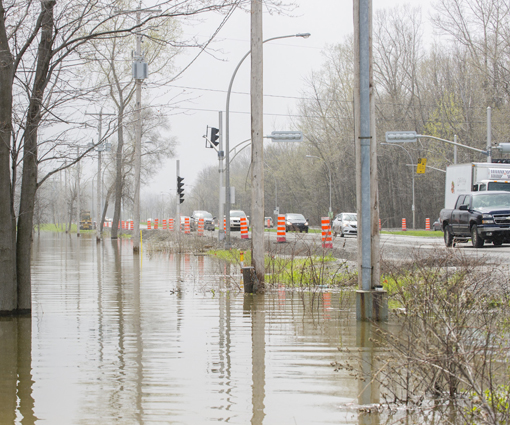Violent storms can bring gusts of wind that cause damage, as well as large hailstones and heavy rain. A tornado that touches down in a forest can uproot a whole swath of trees.

The Charter of the French language and its regulations govern the consultation of English‑language content .

Violent storms can bring gusts of wind that cause damage, as well as large hailstones and heavy rain. A tornado that touches down in a forest can uproot a whole swath of trees.

The width of transmission line rights of way is determined by the voltage of the electric current in the lines. Vegetation must be maintained to prevent flash-overs that could occur during major weather events like strong winds and gusts of wind.

Wet snow is perfect for building snowmen, but it is seven to ten times heavier than powdery snow. This additional weight can cause branches and trees to bend onto the power lines and cause an outage.

When freezing rain accumulates on power lines, it can weigh them down, reducing the safe distance from the surrounding vegetation. Freezing rain can also accumulate on tree branches, causing them to break under the increased weight and fall onto the lines. Ice storms can also cause wooden utility poles and steel towers to fall.

Scroll down
Violent storms can bring gusts of wind that cause damage, as well as large hailstones and heavy rain. A tornado that touches down in a forest can uproot a whole swath of trees.
The width of transmission line rights of way is determined by the voltage of the electric current in the lines. Vegetation must be maintained to prevent flash-overs that could occur during major weather events like strong winds and gusts of wind.
Wet snow is perfect for building snowmen, but it is seven to ten times heavier than powdery snow. This additional weight can cause branches and trees to bend onto the power lines and cause an outage.
When freezing rain accumulates on power lines, it can weigh them down, reducing the safe distance from the surrounding vegetation. Freezing rain can also accumulate on tree branches, causing them to break under the increased weight and fall onto the lines. Ice storms can also cause wooden utility poles and steel towers to fall.

Have severe weather conditions put undue strain on a tree on your property? It could be dangerous to cut it down or prune it, especially if there are power lines nearby. Don’t try to do it yourself: Keep at least three metres away from power lines! For your own safety, leave it to the pros.
Climate change puts pressure on vegetation in different ways.
Here are a few examples:

Climate change could influence the growing period of some plant species. Hydro-Québec must account for this by assessing the impacts of climate change on a regular basis and adapting the frequency and intensity of vegetation control operations as necessary. The reliability of the power system depends on it.

There has been an increase in the frequency of forest fires, which can cause major outages and significant damage to power system equipment. Transmission line corridors can act as barriers that help prevent the spread of forest fires. By reducing the amount of vegetation growing in these corridors, Hydro-Québec can help limit the extent and intensity of a forest fire while also protecting its infrastructure.

Climate change disturbs ecosystems and opens the door to invasive alien species. Among the most widespread is the emerald ash borer, which has caused extensive death in ash trees. The economic and ecological impacts can be considerable, especially in urban areas like Montréal, where there are over 200,000 ash trees.

The increase in extreme precipitation events is having a major impact on the environment. For example, torrential rains can cause landslides and bring down utility poles and towers.